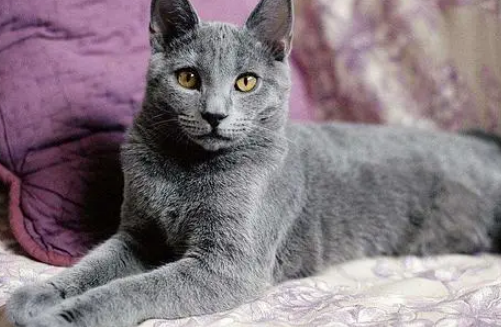Rather than being an impulsive participant in life, the tolerant Chartreuse cat prefers to be a keen observer of life. Chartreuse, which is not particularly talkative compared to most cats, makes a high-pitched meow and occasionally chirps like a bird. Their short legs, stocky stature, and dense short hair belie their true size, and Chartreuse cats are actually late-maturing, powerful, large men.
Although they are good hunters, they are not good fighters. In battles and conflicts, they prefer to retreat rather than attack. There is a little secret code about naming Chartreuse cats: each year has a designated letter (except K, Q, W, X, Y and Z), and the first letter of the cat’s name is This letter corresponds to the year of his birth. For example, if a cat was born in 1997, its name will start with N.
blue male
Male Chartreuse cats are much larger and heavier than female Chartreuse cats, and of course, they are not like buckets. As they age, they also develop a pronounced lower jaw, which makes their heads appear wider.
Chartreuse kitten
Chartreuse cats take up to two years to reach full maturity. Before maturity, their coat will be finer and silkier than ideal. When they are very young, their eyes are not very bright, but as their bodies mature, their eyes become clearer and clearer, until they gradually become dim as they grow older.
Chartreuse cat head
The Chartreuse cat’s head is broad, but not a “sphere.” Their muzzles are narrow, but their rounded whisker pads and strong jaws keep their faces from looking too pointed. From this angle, they should usually look cute with a smile on their face.
Breed History The ancestors of the Chartreuse cat probably came from Syria and followed ships across the ocean to France. In the 18th century, the French naturalist Buffon not only called them “cats of France”, but also gave them a Latin name: Felis catus coeruleus. After World War II, this kind of cat Almost extinct, fortunately, Chartreuse cats and blue Persian cats or British blue cats and mixed-blood survivors hybridize, and it is only through them that this breed can be re-established. In the 1970s, Chartreuse cats arrived in North America, but many European countries stopped breeding Chartreuse cats. Also in the 1970s, FIFe collectively referred to Chartreuse cats and British blue cats as Chartreuse cats, and even At one time, all blue cats in Britain and Europe were called Chartreuse cats, but they were later separated and treated separately.
Chartreuse cat body shape
The Chartreuse cat’s body shape is neither round nor slender, which is called “primitive body shape”. Other nicknames such as “potatoes on matchsticks” are due to their four relatively slender leg bones. In fact, the Chartreuse cats we see today are not very different from their ancestors, as their historical descriptions still exist in the breed standard.
Post time: Oct-20-2023

